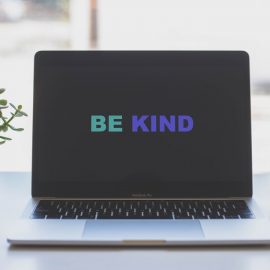

This article gives you a glimpse of what you can learn with Shortform. Shortform has the world’s best guides to 1000+ nonfiction books, plus other resources to help you accelerate your learning.
Want to learn faster and get smarter? Sign up for a free trial here .
Why exactly is empathy? How can you successfully use empathy in communication?
In communication, empathy is important because it sets the tone for all subsequent interactions. Expressing yourself with empathy means clearly and accurately vocalizing your emotions and thoughts in a way that makes the other person willing to listen.
Keep reading to learn about the psychology of empathy, how it develops, and how to express yourself emphatically.
The Psychology of Empathy
Failing to express yourself with empathy often leads to misunderstandings or offenses that can damage relationships, says Daniel Goleman in his book Emotional Intelligence. This issue is especially prevalent when people are upset or discussing sensitive topics. When emotions are running high, people tend to speak before thinking and can say offensive, confusing, or inaccurate things.
Empathy in communication is the root of altruism—people who can’t sense or understand another person’s needs or anguish ultimately don’t care what happens to that other person. Empathy changes the way you look at the world: when other people are in pain, you work to understand their pain and help them through it. You also work not to cause people pain: this is where morals and morality begin.
The lower someone’s capacity for empathy, the less likely they are to identify with suffering that they cannot understand, and the more likely they do not view that suffering as a moral question.
An example of this can be found in some statements on sexual assault. Some male politicians have said, “We wouldn’t want that to happen to our wives, daughters, sisters, or mothers.” Instead of viewing sexual assault as a morally bad thing to happen to anybody under any circumstances, this statement only understands the suffering through direct personal relationships—it’s a more limited display of empathy.
An absence of empathy is incredibly telling: it’s a unifying factor among many troubled people in society, such as criminal psychopaths. This is not a direct correlation. An absence of empathy in communication does not guarantee that someone will become a child molester—but child molesters routinely demonstrate an absence of empathy in communication. Criminals, specifically those who commit their crimes against other people, are usually incapable of communicating with empathy.
An emotional cycle perpetuates these crimes. The perpetrators become wrapped up in their own emotional needs and do not register their victims’ feelings, viewing them instead through a lens where they either cooperate with the acts or deserve them, which sparks the perpetrators’ emotions again.
When offenders who’ve committed these crimes are put through empathy rehabilitation, they learn to put themselves in the shoes of their victims—this essentially robs them of their ability to fantasize that the victims aren’t suffering.
How Empathy Develops
Emotional Intelligence says that in the early stages of our development, we cannot tell ourselves apart from anyone else around us—we interpret everything outside ourselves as part of ourselves. This is why babies mirror our facial expressions. Up until about one year of age, infants perceive any distress around them as if it were their own distress.
At around 2.5 years, toddlers can recognize that someone else’s pain is not their own—now, toddlers can begin to develop the skill of comforting someone else. This is generally the point where babies begin to diverge from one another: some babies become very sensitive toddlers, while others become less sensitive.
Something that seems to have a big impact on which direction toddlers go in is how they get disciplined by their parents. Discipline that hinges on negative judgments of the offending child—“That’s naughty, you’re bad, don’t do that”—doesn’t teach empathy, they teach punishment. Discipline that hinges on explaining how actions make other people feel—“When you hit her, you made her sad. See how she’s crying?”—teaches empathy and builds a toddler’s awareness of other people’s feelings.
Another influencing factor is how their parents and other people react to emotional distress. Toddlers who are yelled at to stop crying will learn that this is how we handle emotions—we punish them. Toddlers who see their parents comforting people in emotional distress, allowing emotions to run their course, and discussing what these emotions are and how we can deal with them, will have a much more positive model of how to deal with emotions.
Listening With Empathy
Nonviolent Communication by Marshall B. Rosenberg provides a helpful framework for maintaining an empathic presence when people express themselves. Just like in expressive communication, when we listen to others in a nonviolent way, we focus on four things: observations, feelings, needs, and requests. Keep in mind that people are always expressing their feelings and needs when they communicate. Focus on listening for those feelings and needs, even when they’re expressed indirectly. For example, if someone says, “I hate my job,” they may really be trying to say, “I feel empty at work because I need recognition when I do a good job.”
Paraphrasing With Questions
When you focus on someone’s feelings and needs, be careful not to take your own interpretations of their words as fact. Instead, check in frequently to make sure you understand exactly what they’re saying. This prevents miscommunications from spiraling out of control and gives the other person a chance to make sure they’re being heard correctly (which ultimately saves everyone time and struggle). To do this, try paraphrasing the feelings and needs you hear in the form of a question.
To illustrate this, let’s look at an example based on a real-life married couple who attended a workshop on NVC techniques. When the husband told his wife, “You never listen,” Rosenberg challenged her to listen for the feelings and needs behind the statement and respond with empathy. Here were her first few attempts:
- “Are you feeling unhappy with me?” This is an understandable question, but the words “with me” imply that her actions have caused her husband’s emotions. She automatically takes responsibility for his feelings, but remember, each of us is only responsible for our own emotions.
- “Are you feeling unhappy because you feel like I don’t understand you?” Here, she’s listening for the feelings as well as the needs behind them. But her language focuses on what her husband might be thinking about her rather than what he’s needing.
- “Are you feeling unhappy because you need to be heard?” This question reflects the husband’s feelings and his needs. It doesn’t matter if she guessed incorrectly about either of these because the question format gives her husband a chance to correct any misunderstanding.
You can also ask paraphrasing questions to clarify what someone is specifically observing (“Are you reacting to your boss skipping the meeting?”) or what they are requesting (“Are you wanting me to help you with this assignment?”).
Notice how these questions are different from questions like “How do you feel about that?” or “What do you need me to do?” These questions are well-intentioned but in practice can sound like analysis, which makes the listener feel like a problem you’re trying to solve. Instead, asking paraphrasing questions makes it clear that you’re really listening and empathizing with someone’s experience, even if you don’t interpret them correctly on the first try.
Expressing Yourself With Empathy
Once you’ve listened to the other person, you must be able to respond to what they’ve said and express yourself effectively. This is a crucial part of practicing empathy in communication. 4 Essential Keys to Effective Communication by Bento C. Leal III argues that doing so requires you to express yourself with empathy—the last ability of effective communication. Expressing yourself with empathy means clearly and accurately vocalizing your emotions and thoughts in a way that makes the other person willing to listen.
Leal explains that failing to express yourself with empathy often leads to misunderstandings or offenses that can damage relationships. This issue is especially prevalent when people are upset or discussing sensitive topics. When emotions are running high, people tend to speak before thinking and can say offensive, confusing, or inaccurate things.
For example, if you’re angry at your partner for continuing to ignore their chores, your strong emotions might lead you to yell at them and accuse them of being lazy. This might cause your partner to resent you and ultimately damage your relationship.
Practice #1: Get Organized
Before you speak, Leal recommends taking a moment to sort out what you’re thinking, how you’re feeling, and what you want to get from the conversation. When we speak before clarifying these factors, our strong emotions might make us confused about what we really want and cause us to act dramatically, possibly saying hurtful things or that we don’t really mean. Acting in this way will make the other person unreceptive to what we’re saying and will likely produce an unsatisfactory end to the conversation. In contrast, planning helps us to express exactly what we need the other person to hear in a way that’s easy for them to understand and that triggers a productive conversation.
For example, if your partner upsets you, your strong emotions might flood you with the urge for revenge when rationally, you want to solve the problem and achieve peace. If you don’t take a second to plan your response, these emotions might cause you to accuse or yell at your partner rather than speak to them with empathy, triggering a major fight. If you’d taken a second to plan your response before speaking, you could have avoided this.
Practice #2: Express Yourself Clearly and Respectfully
Once you’ve determined what you want to say to the other person, Leal recommends expressing yourself in a way that makes your thoughts, feelings, and needs easy for the other person to understand and respond to.
To do this, explain your points one at a time. Furthermore, focus the conversation on your perspective of the situation by using the “I” pronoun rather than the more critical sounding “you.” For example, say “I feel…” rather than “You did…”. You’ll avoid making accusations and assumptions that might make the other person uncomfortable and cause them to disengage from the conversation.
Leal argues that the best way to express yourself clearly and respectfully is to follow a set formula (what he calls an “XYZ Statement”). First, explain the issue in question. Then, explain your perception of the issue. Finally, explain how the issue makes you feel. For example, “Yesterday, my boss called out the quality of my work in front of the office, and it made me think they wanted to publicly embarrass me. It made me feel really ashamed and a little angry at them.”
Practice #3: Continue the Conversation
The final practice of expressing yourself with empathy is allowing the other person to respond and then continuing the discussion until everyone is satisfied. Leal notes that this practice ensures that the conversation comes to a satisfactory end—both parties have fully expressed themselves and fully understand each other. If the discussion is about a problem that needs to be solved, continuing the conversation will ensure that a solution is identified.
To continue the conversation until its natural end, switch back and forth between listening and expressing yourself and follow the practices necessary to perform these abilities. At the end of the conversation, thank the other person for listening.
Final Words
Empathy is an innate human attribute, but the capacity to feel empathy also hinges on one’s upbringing. However, everyone can take steps to develop empathy in communication, which can greatly improve their relationships, both personal and professional. This is because empathy facilitates communication: When you can empathize with another person, you can understand them on a deeper level.
Did you enjoy our article about empathy in communication? Let us know your thoughts in the comments below!

Want to fast-track your learning? With Shortform, you’ll gain insights you won't find anywhere else .
Here's what you’ll get when you sign up for Shortform :
- Complicated ideas explained in simple and concise ways
- Smart analysis that connects what you’re reading to other key concepts
- Writing with zero fluff because we know how important your time is






